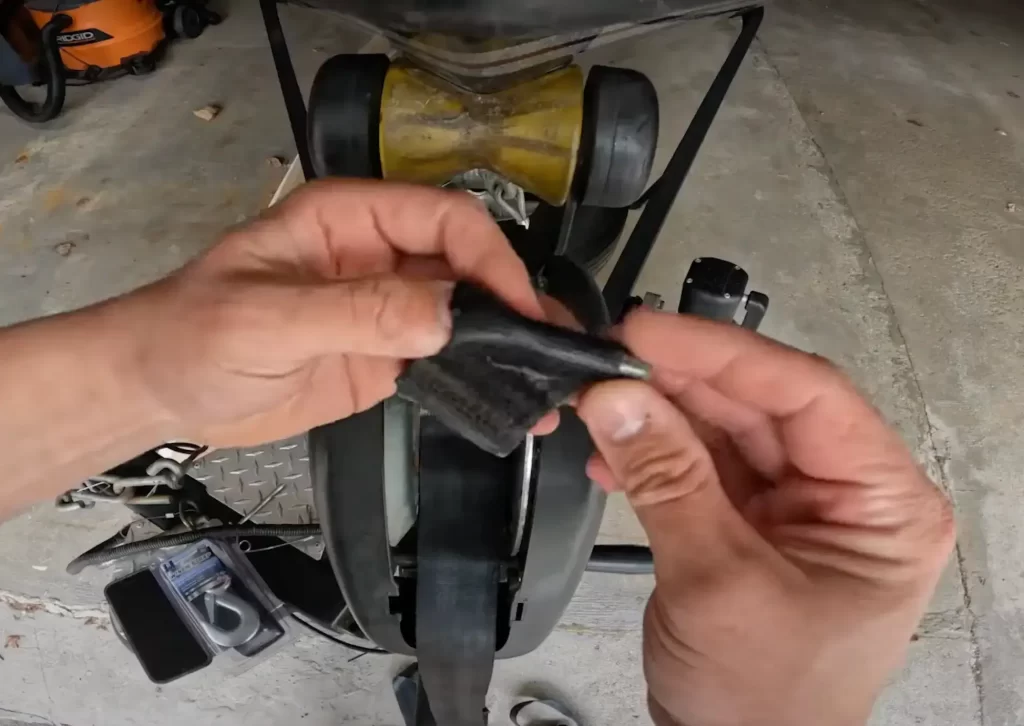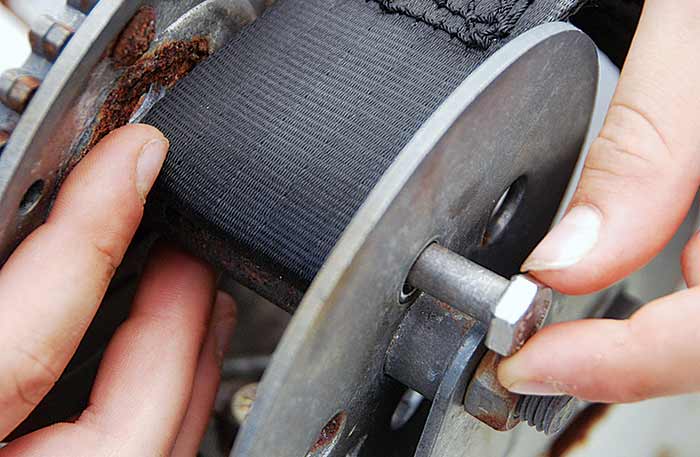Having a well-maintained boat trailer winch on your boat is crucial for safe and smooth sailing.
Over time, the boat trailer winch strap can become worn out or damaged, compromising its performance and putting your safety at risk.
Replacing a worn-out boat trailer winch strap is an essential maintenance task that every boater should know how to do.
This comprehensive guide will walk you through the process, ensuring you can tackle this job with confidence and keep your winch in top condition.
Tools and Materials Required:
- Replacement boat trailer winch strap (ensure it’s the correct size and type for your winch)
- Pliers
- Utility knife or scissors
- Rags
- Lubricant (consult your winch manufacturer’s recommendations)
- Safety gear (gloves, eye protection, etc.)
Here are the key takeaways for how to replace a boat trailer winch strap
- Secure the boat properly before starting to prevent any unwanted movement.
- Release all tension on the existing winch strap before removing it.
- Thoroughly inspect and clean the winch components, lubricating the moving parts.
- Thread the new strap through the winch carefully, following the same pattern as the old strap.
- Ensure the new strap is properly seated in the winch drum and guide channels.
- Secure the strap ends firmly using the recommended method (clamps, knots, and splicing).
- Test the new strap by engaging the winch, and check for even winding without binding.
- Adjust the tension and alignment as needed for smooth, proper operation.
- Secure any loose ends or components to prevent tangling.
- Prioritize safety by wearing protective gear and following manufacturer instructions.
Step 1: Prepare the Boat Winch

Securing the Boat
Before you begin working on the winch, it’s crucial to secure your boat properly to prevent any accidental movements or drifting.
This can be done by tying the boat securely to a dock or mooring buoy, or by dropping an anchor if you’re out on the water.
Ensuring the boat is stable and won’t move unexpectedly is essential for your safety during the strap replacement process.
Releasing Tension on the Existing Boat Trailer Winch Strap
Once the boat is secured, the next step is to release the tension on the existing winch strap.
This is typically done by disengaging the winch mechanism, which can vary depending on the winch model and manufacturer.
Common methods include:
Disengaging the Winch: Many winches have a disengaging lever or switch that allows you to disconnect the winch drum from the gearing system, effectively releasing the tension on the strap.
Using the Release Mechanism: Some winches have a built-in release mechanism, such as a release lever or knob, that allows you to gradually and safely release the tension on the strap.
Winding in the Opposite Direction: In some cases, you may need to wind the winch in the opposite direction to release the tension on the strap gradually.
Removing the Old Boat Trailer Winch Strap:
After the tension is completely released, you can proceed to remove the old winch strap from the winch.
This step requires caution, as the strap may still have some residual tension or be under a load.
Carefully follow the manufacturer’s instructions for your specific winch model, and take note of how the strap is threaded through the winch and secured at the ends.
This will help you when it’s time to install the new strap.
Also check: How to Release a Boat Trailer Winch
Step 2: Inspect and Clean the Winch
Inspect the Winch:
With the old strap removed, you now have a clear view of the winch components. Take this opportunity to thoroughly inspect the winch for any signs of wear, corrosion, or damage.
Here are some key areas to check:
Winch Drum: Examine the winch drum, which is the cylindrical part where the strap winds around. Look for any signs of excessive wear, grooves, or dents that could damage a new strap.
Gears and Internal Components: If possible, inspect the internal gears and components of the winch for any signs of wear, cracks, or damage. Consult the manufacturer’s instructions for accessing these parts safely.
Mounting Points: Check the mounting points where the winch is attached to the boat. Ensure there is no excessive corrosion or looseness that could compromise the winch’s stability.
Bearings and Bushings: If accessible, inspect the bearings and bushings for smooth operation and lubrication.
Clean the Winch Components:
After inspecting the winch, it’s important to clean all the accessible components to remove any built-up grime, salt, or debris.
Use a suitable solvent or cleaner recommended by the winch manufacturer. Avoid using harsh chemicals or abrasives that could damage the winch components.
Cleaning Techniques: Use a clean rag or soft-bristled brush to gently scrub away any accumulated dirt or grime from the winch drum, gears, and other accessible areas.
Removing Corrosion: If you notice any mild corrosion, you can use a specialized corrosion remover or a mild abrasive pad to carefully clean the affected areas. Be gentle and follow the manufacturer’s recommendations.
Lubricate Moving Parts:
After cleaning, it’s essential to lubricate the moving parts of the winch to ensure smooth operation and prevent premature wear.
Consult your winch manufacturer’s recommendations for the appropriate type and amount of lubricant to use.
Lubricating Techniques: Apply the recommended lubricant to all moving parts, such as gears, bearings, and bushings. Use a clean rag or brush to evenly distribute the lubricant.
Avoiding Over-lubrication: Be careful not to over-lubricate, as excess lubricant can attract dirt and debris, leading to potential issues.
Step 3: Install the New Winch Strap

Threading the New Winch Strap:
With the old strap removed and the winch inspected and cleaned, it’s time to install the new winch strap. Start by carefully following the same pattern that the old strap took through the winch mechanism.
This usually involves:
Feeding the Strap through the Winch Drum: Begin by feeding the new strap through the drum of the winch, ensuring it is properly seated in the grooves or channels.
Routing the Strap through Guide Channels: Many winches have guide channels or fairleads that the strap must pass through to ensure proper alignment and prevent chafing or binding.
Following the Manufacturer’s Instructions: Refer to the manufacturer’s instructions for your specific winch model to ensure you are threading the strap correctly. The pattern may vary depending on the winch design.
Ensuring Proper Seating and Alignment:
As you thread the new strap, it’s crucial to ensure that it is properly seated in the winch drum and guide channels.
Check for any twists, kinks, or misalignments that could cause binding or premature wear.
Winch Drum Seating: The strap should sit snugly and evenly in the grooves or channels of the winch drum, without any gaps or overlaps.
Guide Channel Alignment: Make sure the strap is running smoothly through any guide channels or fairleads without rubbing or catching on any edges.
Securing the Strap Ends:
Once the new strap is properly threaded through the winch, you’ll need to secure the ends to prevent it from slipping or coming undone.
The method for securing the ends will depend on the type of strap and the manufacturer’s recommendations, but common methods include:
Clamps or Strap Stops: Many winch straps have clamps or strap stops that can be tightened down to secure the ends in place.
Knots or Splicing: For ropes or braided straps, you may need to tie specific knots or splice the ends to secure them.
Crimping or Swaging: Some straps may require specialized crimping or swaging tools to create a permanent loop or end fitting.
Step 4: Test and Adjust
With the new strap installed, engage the winch and check for proper operation. Adjust the tension and alignment as needed to ensure the strap is winding evenly and without any binding or excessive slack. Secure any loose ends or components to prevent them from getting caught or tangled.
Maintenance and Care Tips:
- Regularly inspect your winch strap for signs of wear, fraying, or damage.
- Keep the winch clean and lubricated according to the manufacturer’s recommendations.
- Properly store and protect the winch and strap when not in use to prevent premature wear or damage.
- If you notice any significant issues or have concerns about the winch’s condition, seek professional assistance from a qualified marine technician.
Safety Precautions
Safety should always be the top priority when working on your boat’s winch system. Exercise caution and follow these best practices:
- Wear appropriate safety gear, including gloves and eye protection, to avoid injuries.
- Secure the boat properly before beginning any work on the winch.
- Release all tension on the winch strap before attempting to remove or replace it.
- Avoid pinch points and keep hands, fingers, and loose clothing clear of moving winch parts.
- Follow the manufacturer’s instructions carefully for your specific winch model.
Troubleshooting Common Issues
If you encounter any difficulties during the winch strap replacement process, here are some common issues and their solutions:
- Strap not winding evenly: Check for proper strap alignment and tension adjustments. Ensure the strap is not binding or catching on any obstructions.
- Excessive strap wear: Inspect the winch components for any rough or sharp edges that could be causing premature wear on the strap. Replace any damaged parts as necessary.
- Winch not engaging properly: Ensure the winch is clean and properly lubricated. Check for any obstructions or damage to the gears or internal components.
FAQs
How often should I replace my boat winch strap?
The frequency of replacement depends on factors such as usage and exposure to the elements. As a general rule, inspect your strap regularly and replace it at the first sign of wear or damage.
Can I use any type of replacement strap?
No, it’s essential to use a replacement strap that is compatible with your specific winch model. Consult your winch’s manual or manufacturer for recommended replacement straps.
What are the signs of a damaged winch strap?
Signs of a damaged winch strap include fraying, tearing, excessive wear, reduced elasticity, and visible cuts or abrasions. If you notice any of these signs, replace the strap immediately.
Conclusion
Replacing a boat winch strap is an essential maintenance task that every boater should feel confident performing. By following this step-by-step guide, you can ensure a safe and effective strap replacement, prolonging the life of your winch system and promoting safe sailing. Remember to prioritize safety, follow the manufacturer’s instructions, and seek professional assistance if needed. With proper care and maintenance, your winch will continue to serve you reliably for years to come.

